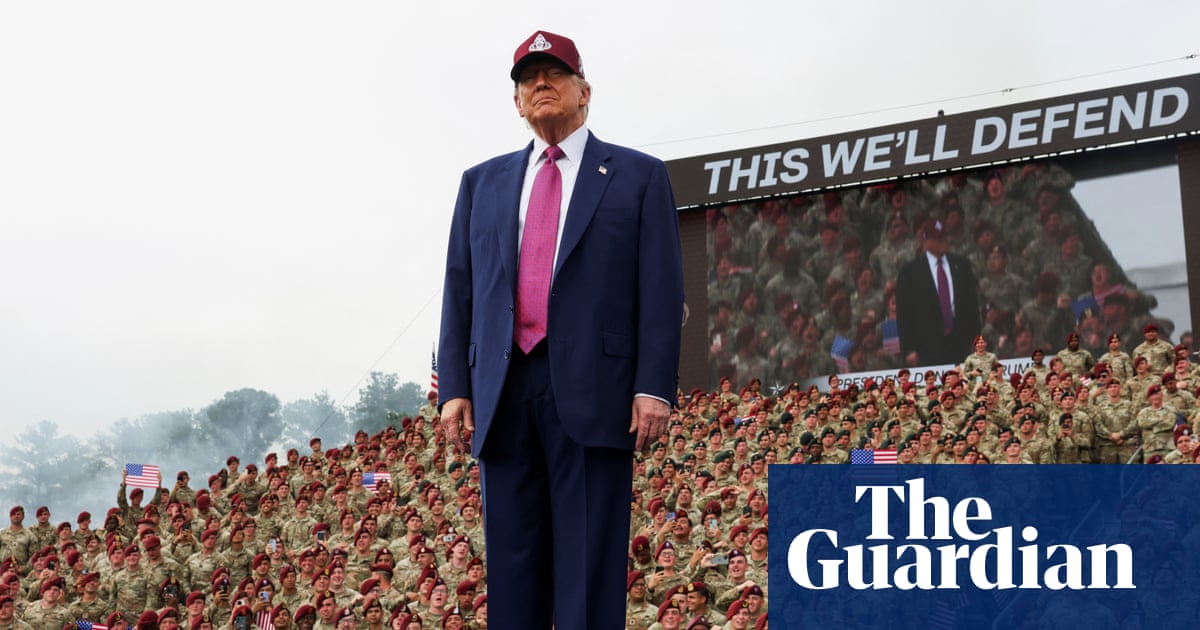Donald Trump was hundreds of miles away from the White House on Tuesday, visiting one the country’s most venerable military bases, Fort Bragg in North Carolina, partly to big-up Saturday’s forthcoming celebration of America’s armed might in Washington – a parade spectacular ostensibly held in honor of the US armed forces’ birthday. But also his own.
With a new setting came the chance for a new theme. Instead the president chose an old one – American carnage.
It was the same discordant melody he had gone off on in his memorably dark first inauguration speech of January 2017, prompting George W Bush – who has kept an otherwise sphinx-like silence on things Trumpian in recent years – to murmur that it was “some weird shit”.
Given the martial setting, it would have been worthier, though unquestionably duller, to hum a tune of virtue and valor.
But withLos Angeles, long his favourite city whipping boy, in the spotlight – by dint of his having dispatched 4,000 national guards troops there on dubious pretext to confront protesters against his immigration roundups – there was never a chance of that.
Confrontation on the streets of what is sometimes called Tinseltown but is more noted by the president’s Maga followers as the capital of “woke” handed Trump the chance to adopt his most favoured posture – the president of permanent emergency.
Having used economic emergency powers to adopt, against all sound advice, tariffs, and other legislation designed to be applied only in wartime to unleash the furies on undocumented migrants, he now had the perfect setting to expound on the extraordinary measures he planned to take against domestic unrest.
“I want to say a few words about the situation in Los Angeles,California,” he told his audience of uniformed active servicemen. Context and setting, you understood, was everything here.
What were once considered policing matters would require, not to put too fine a point on it, military solutions. “The police in LA, who are very good, but they weren’t aggressive, like our soldiers. Our soldiers really were aggressive,” he said.
Weird shit indeed.
The national guard and active Marine Corps deployments in LA, he strongly hinted, would not be the last.
“I will be calling you early, as I see this happening,” he said, expanding his horizons to other settings, taking the opportunity to target Tim Walz, the governor of Minnesota – running mate of Kamala Harris, Trump’s defeated Democratic opponent in last year’s presidential election.
“Because, you know, in theory,” he said, warming – revealingly – to his theme, “I guess you could say a governor could call, but they don’t call. They let their city burn, like in Minneapolis.”
Walz, Trump went, had refused to deploy the national guard in Minneapolis after violence flared in the city amid protests in 2020 following the murder of a Black man, George Floyd, by a white police officer, Derek Chauvin.
“I called the guard and I saved it, but I wish I would have called it the first day,” he said.
In fact,local media reportssay records confirm that it was Walz who called in the national guard. But no matter, Trump had made his intent clear.
TheUS military– buoyed with its new $1tn budget announced in Trump’s ‘big, beautiful bill” and a pay rise announced in his speech – had a new enemy, and it lay inside America’s borders.
Those troops on duty on the streets of Los Angeles were setting the template others could honorably follow.
“Not only are these service members defending the honor of citizens of California, they’re also defending our republic itself,” he said. “And they are heroes. They’re fighting for us. They’re stopping an invasion, just like you’d stop an invasion. The big difference is, most of the time when you stop an invasion, they’re wearing a uniform. In many ways. It’s tougher when they’re not wearing a uniform, because you don’t know exactly who they are.”
For Gavin Newsom, California’s Democratic governor, and Karen Bass, the Los Angeles mayor, there was some ominous “enemy within” language of the type Trump resorted to on last year’s campaign trail.
“They’re incompetent, and they paid troublemakers, agitators and insurrectionists,” he said. “They’re engaged in this willful attempt to nullify federal law and aid the occupation of the city by criminal invaders.”
It was a tour of Trump’s darkest horizons – all the bleaker for being leavened with a comical parting serenade.
As he exited the stage, the PA boomed out his favorite anthem, the Village People’s YMCA. The president drew the biggest cheer of the day from the watching troops by playful indulging in his trademark little dance, culled from distant memories of late nights at Studio 54. Then he waddled off stage, like some aging dystopian disco king.
